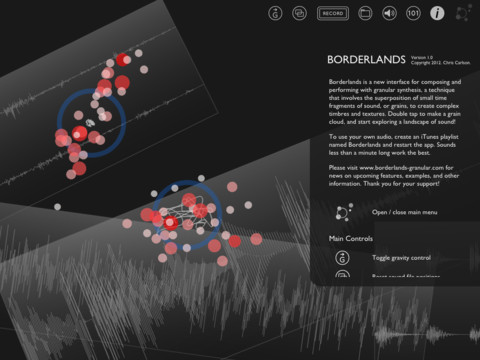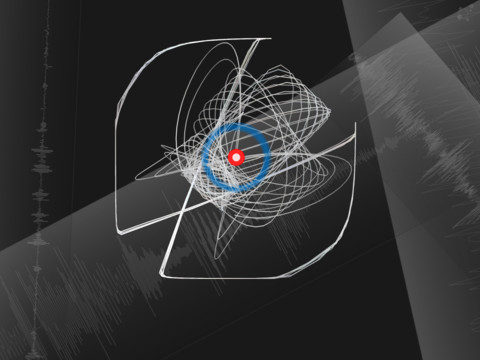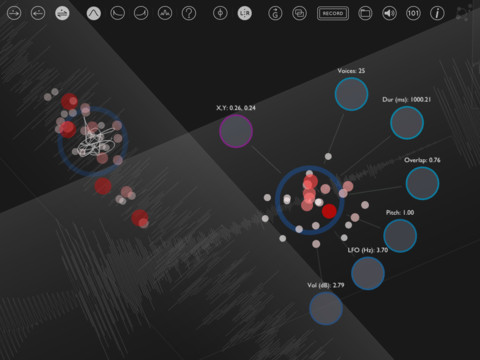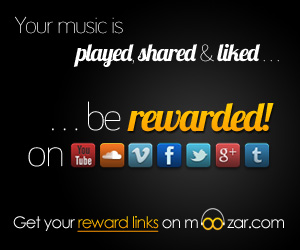By Carolyn Heneghan
The latest high-tech tool for musicians and music lovers, Borderlands Granular, enables users to control and evolve sound using the latest in gestural technology. Developed by Chris Carlson, the instrument favors the user’s gestural interactivity over the knobs and sliders common to most mixing and sound-harnessing instruments.
The demo video depicts a pliable graph interface that looks like something straight out of an iTunes visualizer, with almost psychedelic qualities to it. Waves of sound conjoin, break apart, and mesh in a dissonant bending of sounds that resemble what I’d imagine to be alien transmissions. How to get the app to look and sound like that takes some time spent familiarizing yourself with the complex and intricate gestural interface.
When you first load up the app, on screen you’ll find four overlapping and transparent boxes with sound waves depicted in stark white lines. Double-click any spot on these boxes and a blue circle will appear filled with seemingly erratic red dots, or grains, that fade to white and then pop up elsewhere within the circle. These red dots correspond to a sound located on that particular spot on the sound wave graphs. In the center, a white atomic nucleus spins and jolts around with the sound that’s played, tracking its waves in real time.
Dragging is one way to manipulate the interface. With single-finger swipes you can move the four graphs to separate and align in different ways as well as stretch and rotate them. You can also move the blue circle to different points of these graphs for different combinations of sound. Two-finger swiping over the circle allows you to spin it around at different angles, and it also allows you to tilt the background graphs.
Double-clicking the circle will pull up more circles and options for manipulating the sounds. For example, you can drag the volume circle away from the main circle to increase the sound, and you can drag the LFO or Hz function up and down to dictate the hertz at which the sounds are picked up and played. The pitch will modulate and bend the pitches of the sounds overall, and the overlap function will shrink the atomic nucleus closer into a line so less sounds will play at any one time. The number of voices affects how many different pitches you hear throughout the sound waves, and so on. You can play around with these endlessly to find different versions of the sounds you are creating.
When you double-click another spot on the sound wave graphs, another blue circle will appear and all of the sounds for all blue circles onscreen will play. Some graphs, for example, sound more like voices, and others sound more like chimes or notes on a synthesizer, so manipulating the smaller circles within each of these larger ones will create still more different varieties of what you’ll hear.
The sounds not only fade in and out; when wearing headphones, they also switch from ear to ear, enveloping you in your creations. Depending on where the graphs are lined up, the sounds will not only be dissonant, as the demo might suggest. At times they will sound in perfect if not erratic harmony, sounding something like wind chimes or bits of an overheard phone conversation depending on the frequency and duration of the sounds you’ve selected.
 There are still more and more granular ways you can use this app, more than we could possibly go into in one review. The interface is incredibly expansive and intensive, and has innumerable possibilities built into it—only hindered by the extent of your imagination and ability to play around. But once you mess around with the app, particularly if you are a musician that is familiar with these types of programs, you will unlock the limitless creations of sound that you can control, manipulate, and evolve with just your fingertips.
There are still more and more granular ways you can use this app, more than we could possibly go into in one review. The interface is incredibly expansive and intensive, and has innumerable possibilities built into it—only hindered by the extent of your imagination and ability to play around. But once you mess around with the app, particularly if you are a musician that is familiar with these types of programs, you will unlock the limitless creations of sound that you can control, manipulate, and evolve with just your fingertips.
You can also upload your own sounds by creating a playlist named Borderlands in iTunes and syncing it with the app. This way you can manipulate your own creations from other music tools in a unique, gestural-controlled way.
This iPad-only app has been optimized for the iPad 2 and 3. It will run on the first generation tablet but will perform much more slowly due to heavy audio processing requirements.
The app is available for download on the App Store for $3.99.


















Comments are closed.